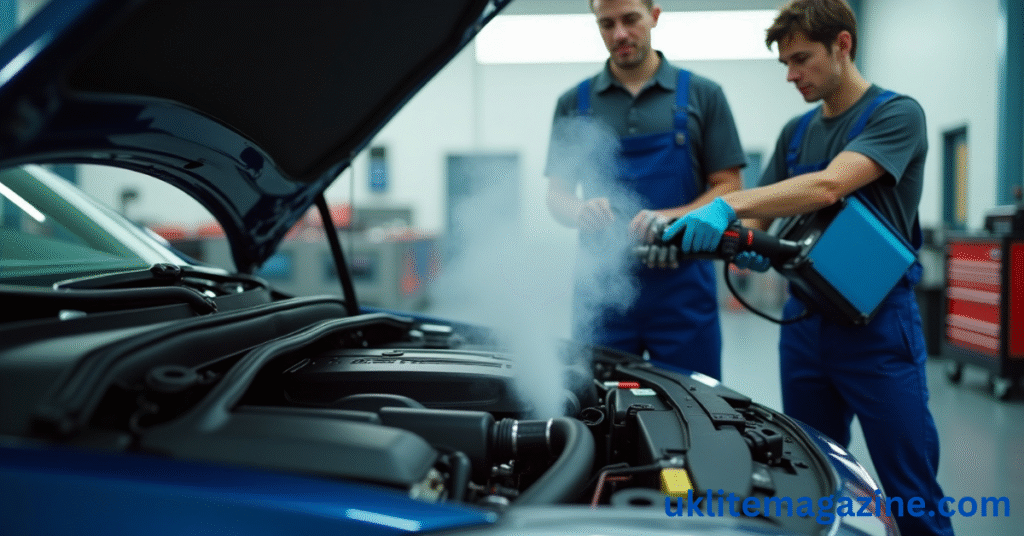If you’ve seen the check engine light come on and your mechanic mentions an EVAP system leak, you might wonder what that means. The EVAP (Evaporative Emission Control) system plays a vital role in reducing pollution, but like any other car system, it can fail over time. This article will explain what an EVAP system leak is, how to fix it, how much it may cost, and why it’s important not to ignore it.
What Is an EVAP System Leak?
The EVAP system prevents gasoline vapors in your fuel tank from escaping into the air. Instead, it captures the vapors and routes them back into the engine to be burned during combustion.
An EVAP system leak means there’s a hole, crack, or loose connection somewhere in this sealed system. As a result, gasoline vapors escape, which can lead to pollution and decreased fuel efficiency.
How Does the EVAP System Work?
The EVAP system includes:
-
Fuel tank
-
Vapor lines
-
Charcoal canister
-
Purge valve
-
Vent valve
-
Gas cap
When functioning correctly, vapors are collected in the charcoal canister and sent back to the engine through the purge valve. A leak anywhere in this system can trigger the check engine light.
Common Symptoms of an EVAP System Leak
| Symptoms | Explanation |
|---|---|
| Check Engine Light | Most common sign, usually shows as error code P0440–P0457 |
| Strong fuel smell | Escaping vapors can smell like gasoline |
| Failed emissions test | Leaks allow pollutants to escape into the air |
| Decreased fuel efficiency | Leaks can slightly reduce MPG |
| Trouble starting after fueling | Vapor pressure issues may make it harder to start your car |
What Causes an EVAP System Leak?
Here are the most common causes of an EVAP system leak:
| Cause | Details |
|---|---|
| Loose or damaged gas cap | The most frequent issue and easiest to fix |
| Cracked vapor hoses | Rubber hoses can become brittle and crack over time |
| Faulty purge or vent valve | These valves can fail and cause a leak |
| Damaged charcoal canister | Can break or get saturated with fuel |
| Rusted fuel tank neck | Common in older vehicles |
How to Fix an EVAP System Leak
Here’s how to go about identifying and fixing the issue:
1. Check the Gas Cap
-
Make sure it’s tightened correctly.
-
Replace if cracked or worn. This alone fixes many EVAP leaks.
2. Use an OBD-II Scanner
-
Plug in a scanner to get error codes like P0442 (small leak) or P0455 (large leak).
-
These codes help narrow down the problem.
3. Do a Smoke Test
-
A smoke machine blows non-toxic smoke into the EVAP system.
-
The smoke will exit through the leak, showing you exactly where the problem is.
4. Replace Faulty Components
-
If a valve or hose is bad, replace it.
-
Charcoal canisters and sensors may also need replacement in some cases.
Is an EVAP Leak Expensive to Fix?
The cost can vary depending on the problem:
| Repair Needed | Estimated Cost |
|---|---|
| New gas cap | $10 – $40 |
| Vapor hose replacement | $50 – $100 |
| Purge or vent valve replacement | $100 – $300 |
| Charcoal canister replacement | $200 – $600 |
| Full smoke test at shop | $60 – $150 |
A loose gas cap is a cheap fix, while a charcoal canister replacement is on the higher end.
Can You Drive With an EVAP System Leak?
Yes, but it’s not recommended for a long time. It won’t typically affect how your car drives, but:
-
It will pollute the air.
-
You may fail your next emissions test.
-
It can lead to other issues if moisture enters the system.
Preventing Future EVAP Leaks
-
Always tighten your gas cap until it clicks.
-
Don’t overfill your gas tank.
-
Have your emissions system checked annually.
-
Replace worn-out hoses and components early.
Conclusion
An EVAP system leak may sound like a serious issue, but it’s often something simple like a loose gas cap. Still, it’s essential to fix it promptly to reduce pollution, avoid further damage, and pass your emissions test. Using a scanner and smoke test can help locate the problem quickly. Depending on the repair, the cost may be low, especially if you can diagnose and fix it yourself.
Frequently Asked Questions (FAQs)
What is a EVAP system leak?
An EVAP system leak means there’s a hole or loose connection in the system that prevents gasoline vapors from being properly contained and recycled, leading to emissions and possibly triggering your check engine light.
How do you fix an EVAP system leak?
Start by checking and replacing the gas cap. If that doesn’t fix it, use an OBD-II scanner and smoke test to find leaks in hoses or valves. Replace any damaged components.
Is an EVAP leak expensive to fix?
It depends. A loose gas cap is cheap, but replacing parts like a charcoal canister can cost several hundred dollars. On average, repairs range from $20 to $600.
What is the most common EVAP leak?
The most common cause is a loose or cracked gas cap, which is also the easiest and cheapest fix.

